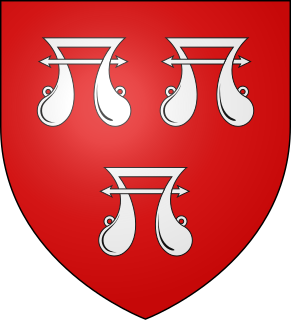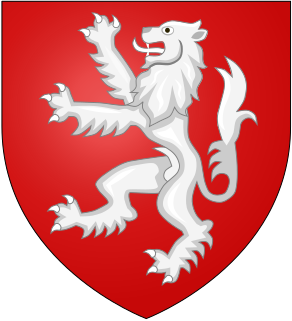Related Research Articles
Roger Bigod was a Norman knight who travelled to England in the Norman Conquest. He held great power in East Anglia, and five of his descendants were earls of Norfolk. He was also known as Roger Bigot, appearing as such as a witness to the Charter of Liberties of Henry I of England.

Peter I, also known as Peter Mauclerc, was Duke of Brittany jure uxoris from 1213 to 1221, and regent of the duchy for his minor son John I from 1221 to 1237. As duke he was also 1st Earl of Richmond from 1218 to 1235.
Sir Robert de Ros was an English nobleman.

William Ros or Roos, 1st Baron Ros of Helmsley, was one of the claimants of the crown of Scotland in 1292 during the reign of Edward I.

William III de Ferrers, 5th Earl of Derby of Chartley Castle in Staffordshire, was an English nobleman and major landowner, unable through illness to take much part in national affairs. From his two marriages, he left numerous children who married into noble and royal families of England, France, Scotland and Wales.

The House of Mowbray is an Anglo-Norman noble house, derived from Montbray in Normandy and founded by Roger de Mowbray, son of Nigel d'Aubigny.

Charles Stewart, 3rd Duke of Richmond, 6th Duke of Lennox KG of Cobham Hall in Kent and of Richmond House in Whitehall, London, 12th Seigneur d'Aubigny in France, was an English nobleman of Franco-Scottish ancestry and a 4th cousin of King Charles II of England, both being descended in the male line from John Stewart, 3rd Earl of Lennox.
William d'Aubigny, 3rd Earl of Arundel, also called William de Albini IV, was an English nobleman, a favourite of King John, and a participant in the Fifth Crusade.

Dervorguilla of Galloway was a 'lady of substance' in 13th century Scotland, the wife from 1223 of John, 5th Baron de Balliol, and mother of John I, a future king of Scotland.
William Malet, feudal baron of Curry Mallet in Somerset, was one of the guarantors of Magna Carta. In 1190, he accompanied King Richard the Lionheart on crusade. While still on crusade in 1191, he took part in the Siege of Acre. Upon returning to England, he served as Sheriff of Somerset and Dorset in 1209. The precise nature of his relationship to an earlier William Malet is unknown.
Nigel d'Aubigny, was a Norman Lord and English baron who was the son of Roger d’Aubigny and Amice or Avice. His father was an avid supporter of Henry I of England, and his brother William d'Aubigny Pincerna was the king's Butler and father of the 1st Earl of Arundel. Nigel was born at Thirsk Castle in Thirsk, North Yorkshire, Kingdom of England. He was the founder of the noble House of Mowbray.
Maud Marshal, Countess of Norfolk, Countess of Surrey was an Anglo-Norman noblewoman and a wealthy co-heiress of her father William Marshal, 1st Earl of Pembroke, and her mother Isabel de Clare suo jure 4th Countess of Pembroke. Maud was their eldest daughter. She had two husbands: Hugh Bigod, 3rd Earl of Norfolk, and William de Warenne, 5th Earl of Surrey.
Robert III de Stuteville was an English baron and justiciar.
William de Mowbray, 6th Baron of Thirsk, 4th Baron Mowbray was a Norman Lord and English noble who was one of the twenty-five executors of Magna Carta. He was described as being as small as a dwarf but very generous and valiant.
William d'Aubigny, sometimes William de Albini, was an Anglo-Norman baron and administrator who served successive kings of England and acquired large estates in Norfolk. From his title of Butler to King Henry I of England, he was called William d'Aubigny Pincerna to distinguish him from other men of the same name.

The feudal barony of Eaton Bray in Bedfordshire was an English feudal barony founded in 1205 when the manor of Eaton was granted by King John to his household steward William I de Cantilupe (d.1239), together with many others, including Aston in Warwickshire. In 1221 Cantilupe built a castle at Eaton, which became the caput of his feudal barony and was described by the monks of nearby Dunstable Priory in the Annals of Dunstable as being "a serious danger to Dunstable and the neighbourhood". The grant was for knight-service of one knight and was in exchange for the manor of Great Coxwell, Berkshire, which had been granted to him previously but the grant was deemed compromised. Eaton had been held at the time of William the Conqueror by the latter's uterine half-brother Odo, Bishop of Bayeux, but later escheated to the crown.
William de Ireby, Master of the Royal Hounds and Sheriff of Westmorland, was an English knight from Cumbria.
Hugh de Morville Baron of Burgh, Lord of Kirkoswald, was an English noble.

William de Greystoke, sometimes known as William FitzRanulf, Baron of Greystoke, was an English noble.
William de Stuteville Baron of Cottingham, Lord of Buttercrambe, was an English noble.
References
- ↑ Sanders, I.J. English Baronies: A Study of their Origin and Descent 1086-1327. Oxford, 1960. p. 37